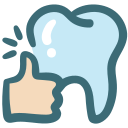Understanding Teeth Whitening: Process, Alternatives and Side effects

- Whitening
- 22 Aug 2023
Overview
About Teeth Whitening
A cosmetic dental technique, teeth whitening, is done to whiten teeth and remove stains or discoloration. It is done to make the smile more beautiful and brighter. The teeth whitening process can be done in many ways, such as in-office procedures performed by a dentist, at-home kits with custom trays or strips, and over-the-counter items like whitening toothpaste or gels.1Overview| Researched based study from Nlm.nih.gov
In this article we will learn more about the various methods of whitening, its side effects, and the post-operative care to avoid the side effects.

Teeth Staining
How do teeth become stained?
- Foods and drinks
- Tobacco
- Poor oral hygiene
- Age
- Medicine
- Trauma
- Fluorosis
- Genetics
- Previous dental fillings
It may happen for several reasons. The typical reasons for dental discoloration include:
Foods and drinks
- Teeth can become stained by ingesting foods and drinks with a dark color, such as coffee, tea, and some spices.
Tobacco use
- Since nicotine and tar are included in tobacco products, chewing or smoking can severely discolor teeth.
Oral hygiene issues
- Plaque and tartar can accumulate due to insufficient brushing and flossing, making teeth seem yellow or brown.
Age
- The dentin’s original yellowish color may be revealed as the outer layer of enamel wears away with age, giving teeth a darker appearance.
Medications
- Some medications, including antipsychotics, antihistamines, and tetracycline antibiotics, can result in intrinsic staining, which develops from within the tooth and is more difficult to cure.
Dental trauma
- Discoloration after dental trauma is occasionally possible, significantly if the tooth pulp is affected.
Fluorosis
- Fluoride intake that is too high during development might result in chlorosis, which produces brown or white stains.
Genetics
- Because of their genetic makeup, which can affect the thickness and color of enamel, some people are more likely to be teachers.
Restorative dental work
- Localized discoloration from dental materials like amalgam fillings is possible.
Disease and medical intervention
- Some medical interventions, such as radiation therapy, might have staining as a side effect.5Teeth staining| Researched based study from Nlm.nih.gov ,6Teeth staining| Researched based study from Nlm.nih.gov
The Process
Teeth whitening procedure
The following steps are commonly included in the teeth-whitening method:
Examination of the teeth
- Before starting the procedure, your dentist will examine your teeth and gums to make sure they are sound and acceptable.
Cleaning
- To improve treatment efficacy, a dental cleaning may be done to remove any plaque, tartar, or surface stains.
Shade evaluation
- The dentist will determine the color of your teeth as they are right now in order to create a baseline for comparison after the surgery.
Gum protection
- A gel or rubber shield protects your gums from the bleaching agent.
Application of the agent
- A whitening chemical, typically containing hydrogen peroxide or carbamide peroxide, will be applied to the surface by the dentist. The agent may be activated using a laser or specialized light, depending on the technique.
Waiting time
- You must enable the whitening chemical to penetrate and break down stains on your teeth for a specific period.
Rinse and repeat
- After the initial treatment, the dentist could reapply the whitening agent for improved results7The Process| Researched based study from Ada.org
Post-Operative care
Post-Operative care
It is crucial to adhere to the recommended post-treatment maintenance to maintain the results and protect the health of your teeth after teeth whitening. Here are a few pieces of advice:
Food to avoid
- During the first 24 to 48 hours, it is best to stay away from foods and beverages that can stain teeth, such as coffee, tea, red wine, dark-colored sauces, and berries.
- Acidic substances have the potential to harm tooth enamel, making it more susceptible to discoloration.
Quit smoking
- Smoking can cause yellow teeth or discolor them. Therefore, it’s best to stop or steer clear of all tobacco products.
Use a straw
- If you drink stain-causing liquids, use a straw to reduce contact with your teeth.
Maintaining proper oral hygiene
- To remove plaque and stop stains from forming, brush your teeth at least twice a day and every day. Consider using toothpaste designed for sensitive teeth to lessen discomfort from the procedure.
Rinsing your mouth
- Suppose you consume foods or beverages that stain. After brushing, rinse your mouth with water to help lessen the chance of discoloration.
Make use of whitening toothpaste
- To help keep the brightness, include a whitening toothpaste in your daily oral care regimen.
Schedule regular dental checkups
- To protect the overall health of your teeth and to address any issues regarding the treatment, schedule frequent cleanings and checkups with your dentist.
Side effects

Side effects of Whitening
When done by a competent dental professional or using recognized over-the-counter products as indicated, it is generally considered safe. As with any dental procedure, there may be potential dangers and adverse effects. A few of these are:
- Sensitivity
- Gum irritation
- Uneven whitening
- Temporary white spots
- Soft tissue irritation
- Damage to existing dental work
- Enamel degradation
Sensitive teeth
- The most frequent side effect is sensitivity. The teeth’s nerve endings may become more sensitive due to the whitening substances, making consuming hot, cold, or sweet foods and beverages challenging.
- It can occasionally irritate the tooth pulp, causing minimal discomfort. This occurs more frequently in persons who are already sensitive.
Gum irritation
- If they make direct touch with the gums, it could irritate them. Temporary gum irritation or inflammation may result, but it usually disappears after treatment.
Uneven whitening
- Teeth might not whiten evenly, producing uneven results. This may happen if the whitening solution is not administered evenly to all teeth or if any crowns or other dental restorations are currently in place and are resistant to the treatment.
Temporary white spots
- Sometimes, teeth may get white spots, mainly if too many agents are employed. These typically deteriorate with time.
Irritation of soft tissues
- The soft tissues in the mouth, such as the cheeks or lips, might become irritated by whitening trays or strips that do not fit properly.
Damage to existing dental work
- If they are a different color from the natural teeth, they may not be effective on dental restorations like veneers or crowns and may make them stand out.
Enamel degradation and excessive use
- Using whitening products excessively or frequently might cause enamel erosion, increasing the risk of cavities and sensitivity.5Side effects| Researched based study from Nlm.nih.gov ,6Side effects| Researched based study from Nlm.nih.gov
Alternatives
Teeth Whitening alternatives
At-home tools
- These can be purchased over the counter and frequently come in gels, strips, or trays. Compared to office treatments, they include a lesser concentration of whitening chemicals. You use the product on your teeth following the directions supplied.
Toothpaste
- Mild abrasives found in whitening toothpaste can aid in removing surface stains. However, because they lack bleach or other active ingredients, they are less efficient at altering the natural color of teeth.
Whitening strips
- These delicate, flexible strips are placed on the teeth and covered with a gel. They are often worn for a specific amount of time spaced out over a few weeks.
Trays
- The gel is placed in a custom-fitted tray, which is placed over the teeth for a predetermined period. While certain amount can be purchased over the market, others are given by the dentist.
Mouth rinses
- Similar to traditional mouthwash it also includes hydrogen peroxide or other ingredients. You can gargle with the rinse for the advised amount of time.2Alternatives| Researched based study from Nlm.nih.gov ,3Alternatives| Researched based study from Nlm.nih.gov ,4Alternatives| Researched based study from Nlm.nih.gov
Any feedback on this article?
 This Articles content was accurate
This Articles content was accurate Very Informative Article
Very Informative Article I have a question or a comment
I have a question or a comment
 This article contains inaccurate content
This article contains inaccurate content This article was not helpful
This article was not helpful I have a question or a comment
I have a question or a comment
We appreciate your helpful feedback!
Checkout our social pages
References
-
National Library of Medicine
Tooth Whitening: What We Now Know | Overview
-
National Library of Medicine
Dental Bleaching Techniques; Hydrogen-carbamide Peroxides and Light Sources for Activation, an Update. Mini Review Article | The Process | Alternatives
-
National Library of Medicine
Dental Whitening Gels: Strengths and Weaknesses of an Increasingly Used Method | The Process | Alternatives
-
National Library of Medicine
A Radical-Free Approach to Teeth Whitening | The Process | Alternatives
-
National Library of Medicine
Post-Operative Sensitivity and Color Change Due to In-Office Bleaching With the Prior Use of Different Desensitizing Agents: A Systematic Review | Side effects | Teeth staining
-
National Library of Medicine
Tooth-bleaching procedures and their controversial effects: A literature review | Side effects | Teeth staining
-
American Dental Association
Whitening | The Process


































